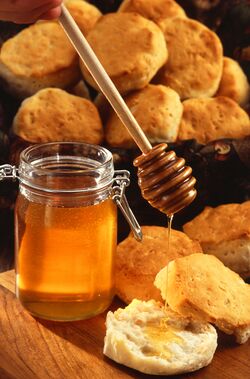Honey
(food) | |
|---|---|
 | |
| Foodstuff with large temptation for adulteration |
"Tests Show Most Store Honey [in US] Isn't Honey".[1]
Adulteration
Honey is sometimes adulterated by the addition of other sugars, syrups, or compounds to change its flavor or viscosity, reduce cost, or increase the fructose content to stave off crystallization. Adulteration of honey has been practiced since ancient times, when honey was sometimes blended with plant syrups such as maple, birch, or sorghum and sold to customers as pure honey. Sometimes crystallized honey was mixed with flour or other fillers, hiding the adulteration from buyers until the honey was liquefied. In modern times the most common adulterant became clear, almost-flavorless corn syrup; the adulterated mixture can be very difficult to distinguish from pure honey.[2]
According to the Codex Alimentarius of the United Nations, any product labeled as "honey" or "pure honey" must be a wholly natural product, although labeling laws differ between countries.[3] In the United States, according to the National Honey Board (NHB;[4] supervised by the United States Department of Agriculture),[5][6] "honey stipulates a pure product that does not allow for the addition of any other substance... this includes, but is not limited to, water or other sweeteners".[7]
Isotope ratio mass spectrometry can be used to detect addition of corn syrup and cane sugar by the carbon isotopic signature. Addition of sugars originating from corn or sugar cane (C4 plants, unlike the plants used by bees, and also sugar beet, which are predominantly C3 plants) skews the isotopic ratio of sugars present in honey,[8] but does not influence the isotopic ratio of proteins. In an unadulterated honey, the carbon isotopic ratios of sugars and proteins should match. Levels as low as 7% of addition can be detected.[9]
References
- ↑ https://www.foodsafetynews.com/2011/11/tests-show-most-store-honey-isnt-honey/
- ↑ The Hive: The Story of the Honeybee and Us By Bee Wilson --St. Martins Press 2004 Page 167
- ↑ https://doi.org/10.1007%2F978-1-4613-1119-5_8
- ↑ https://www.honey.com/files/general/Honey-Definitions.pdf |publisher=National Honey Board
- ↑ https://www.honey.com/about-the-nhb
- ↑ https://www.ams.usda.gov/rules-regulations/research-promotion/honey
- ↑ https://www.bjcp.org/mead/honeydefs.pdf
- ↑ https://books.google.com/books?id=EXqeDGfKDhIC&pg=PA469
- ↑ https://web.archive.org/web/20080617102807/http://www.honeycouncil.ca/users/folder.asp?FolderID=4846